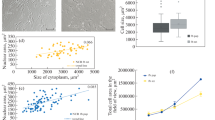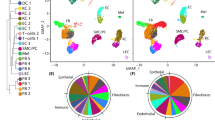Summary
In progressive systemic scleroderma, excessive deposition of collagen leads to fibrosis of several tissues including the skin. It has been found that different populations of fibroblasts are present in scleroderma skin; these can be obtained by establishing cell cultures from different layers of the involved skin. Excessive overproduction of collagen was noted in primary cultures of cells obtained from deeper layers of the skin of patients in an early stage of the disease, whereas control fibroblasts did not manifest significant variations dependent on the layers of skin used to initiate the cultures. The synthesis of type-I and-III collagen was found to be altered concomitantly. The production of collagen and collagenous proteins was then followed during subcultivations of overproducing fibroblasts. In many cell strains, increased synthesis of collagen and/or noncollagenous proteins had already been lost after the first subcultivation, whereas overproduction was stable in others. However, after five passages, most of the cultures showed normal collagen synthesis, which probably indicates a loss of phenotype due to successive subcultures or overgrowth by another population of fibroblasts.
Similar content being viewed by others
References
Bonner WM, Lasky RA (1974) A film-detection method for tritium-labelled proteins and nucleic acids in polyacrylamide gels. Eur J Biochem 46:83–88
Buckingham RB, Prince RK, Rodnan GP, Taylor F (1978) Increased collagen accumulation in dermal fibroblast cultures from patients with progressive systemic sclerosis (scleroderma). J Lab Clin Med 92:5–21
Buckingham RB, Prince RK, Rodnan GP, Barnes EC (1980) Collagen accumulation by dermal fibroblast cultures of patients with linear localized scleroderma. J Rheumatol 7:130–142
Fleischmajer R (1971) The pathophysiology in scleroderma. Int J Dermatol 16:310–318
Fleischmajer R, Nedwich A (1972) Generalized morphea. I. Histology of the dermis and subcutaneous tissue. Arch Dermatol 106:509–514
Fleischmajer R, Perlish JS, Krieg T, Timpl R (1981) Variability in collagen and fibronectin synthesis by scleroderma fibroblasts in primary culture. J Invest Dermatol 76:400–403
Fleischmajer R, Perlish JS, Duncan M (1984) Scleroderma: a model for fibrosis. Arch Dermatol (in press)
Krieg T, Muller PK, Goerz G (1977) Fibroblasts from a patient with scleroderma reveal abnormal metabolism. Arch Dermatol Res 259:105–107
Krieg T; Aumailley M, Dessau M, Wiestner M, Muller P (1980) Synthesis of collagen by human fibroblast and their SV-40 tranformants. Exp Cell Res 125:23–31
Krieg T, Braun-Falco O, Perlish JS, Fleischmajer R (1983) Collagen synthesis in generalized morphea. Arch Dermatol Res 275:393–396
Laemmli HK (1970) Cleavage of structural proteins during the assembly of the head of bacteriophage T4. Nature 227:680–685
Layman DL, McGoodwin EB, Martin GR (1971) The nature of the collagen synthesized by cultured human fibroblasts. Proc Natl Acad Sci USA 68:454–458
LeRoy C (1974) Increased collagen synthesis by scleroderma fibroblasts in vitro. J Clin Invest 54:880–889
Lowry OH, Rosebrough NJ, Farr AC, Randall RJ (1951) Protein measurement with the Folin phenol reagent J Biol Chem 193:265–275
Perlish JS, Bashey RJ, Stephens RE, Fleischmajer R (1976) Connective-tissue synthesis by cultured scleroderma fibroblsts. 1. In vitro collagen synthesis by normal and scleroderma dermal fibroblasts. Arthritis Rheum 195:891–901
Uitto J, Bauer E, Eisen A (1979) Scleroderma: increased biosynthesis of triple-helical type-I and type-III procollagens associated with unaltered expression of collagenase by skin fibroblasts in culture. J Clin Invest 64:921–930
Wiestner M, Krieg T, Hörlein D, Glanville R, Fietzek P, Muller P (1979) Inhibiting effect of procollagen peptides on collagen biosynthesis in fibroblasts cultures. J Biol Chem 254:7016–7023
Winkelmann RK (1976) Pathogenesis and staging of scleroderma. Acta Derm Venereol (Stockh) 56:83–92
Author information
Authors and Affiliations
Rights and permissions
About this article
Cite this article
Krieg, T., Perlish, J.S., Fleischmajer, R. et al. Collagen synthesis in scleroderma: Selection of fibroblast populations during subcultures. Arch Dermatol Res 277, 373–376 (1985). https://doi.org/10.1007/BF00509236
Received:
Issue Date:
DOI: https://doi.org/10.1007/BF00509236




